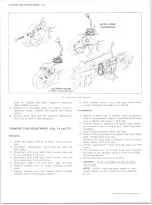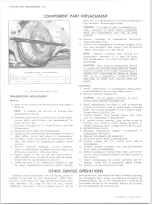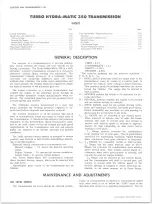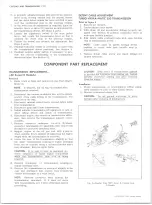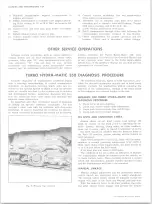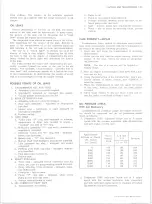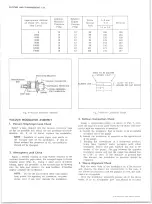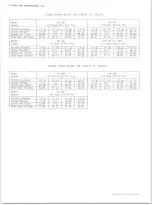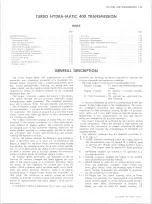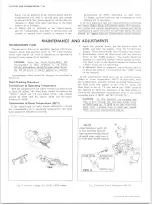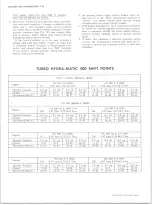
CLUTCHES AND TRANSMISSIONS 7-25
from rolling. The pointer on the indicator quadrant
should line up properly with the range indicators in all
ranges.
OIL LEAKS
Before attempting to correct an oil leak, the actual
source of the leak must be determined. In many cases,
the source of the leak can be deceiving due to “ wind
flow” around the engine and transmission.
The suspected area should be wiped clean of all oil be
fore inspecting for the source of the leak. Red dye is
used in the transmission oil at the assembly plant and
will indicate if the oil leak is from the transmission.
The use of a “ black light” to identify the oil at the
source of leak is also helpful. Comparing the oil from
the leak to that on the engine or transmission dip stick
(when viewed by black light) will determine the source
of the leak.
Oil
leaks around the engine and transmission are gen
erally carried toward the rear of the car by the air
stream. For example, a transmission “ oil filler tube to
case leak” will sometimes appear as a leak at the rear
of the transmission. In determining the source of an oil
leak it is most helpful to keep the engine running.
POSSIBLE POINTS OF OIL LEAKS
1. TRANSMISSION OIL PAN LEAK
a. Attaching bolts not correctly torqued.
b. Improperly installed or damaged pan gasket.
c. Oil pan gasket mounting face not flat.
2. REAR EXTENSION LEAK
a. Attaching bolts not correctly torqued.
b. Rear seal assembly - damaged or improperly
installed.
c. Gasket seal - (extension to case) damaged or
improperly installed.
d. Porous casting.
3„ CASE LEAK
a. Filler pipe “ O” ring seal damaged or missing;
misposition of filler pipe bracket to engine -
“ loading” one side of “ O” ring.
b. Modulator assembly “ O” ring seal - damaged or
improperly installed.
c. Governor cover, and “ O” ring seal - damaged,
loose; case face leak.
d. Speedo gear - “ O” ring damaged.
e. Manual shaft seal-damaged, improperly installed.
f. Line pressure tap plug - stripped, shy sealer
compound.
g. Parking pawl shaft cup plug - damaged, improp
erly installed.
h. Vent pipe (refer to Item 5).
i . Porous case.
4. FRONT END LEAK
a. Front seal - damaged (check converter neck for
nicks, etc.,also for pump bushing moved forward).
b. Pump attaching bolts and seals - damaged, miss
ing, bolts loose.
c. Converter - leak in weld.
d. Pump “ O” ring seal - damaged. (Also check
pump groove and case bore.)
e. Porous casting (pump or case).
5. OIL COMES OUT VENT PIPE
a. Transmission over-filled.
b. Water in oil.
c. Pump to case gasket mispositioned.
d. Foreign material between pump and case, or be
tween pump cover and body.
e. Case - porous, pump face improperly machined.
f . Pump - shy of stock on mounting faces, porous
casting.
CASE POROSITY—REPAIR
Transmission leaks caused by aluminum case porosity
have been successfully repaired with the transmission in
the vehicle by using the following procedure.
1. Road test and bring the transmission to operating
temperature.
2. Raise the car and, with the engine running, locate the
source of the leak. Check for leaks in all operat
ing positions.
N O T E :
The use of a mirror will be helpful in
finding leaks.
3. Shut off engine and thoroughly clean area with a sol
vent and air dry.
4. Using the instruction of the manufacturer, mix a suf
ficient amount of epoxy cement, part #1360016, to
make the repair.
5. While the transmission is still hot, apply the epoxy
to the area, making certain that the area is fully
covered.
6. Allow epoxy cement to dry for three hours and re
test for leaks, as outlined in Steps 1 and 2.
OIL PRESSURE CHECK
W ith Car Stationary
Transmission oil pressure gauge and engine tachome
ter should be connected and the oil pressures should
check as follows:
1. Pressures (PSI) indicated below are at 0 output
speed with the vacuum modulator tube disconnected
and with engine at 1200 rpm.
Approximate
Altitude of Check
(Ft. Above
Sea Level)
Drive
Neutral
Park
L-6 and
V-8
Reverse
LI or L2
0
168
166
254
2000
158
159
240
4000
149
153
227
6000
141
147
214
8000
133
141
202
10000
126
135
191
12000
119
130
181
14000
113
126
171
2. Pressures (PSI) indicated below are at 0 output
speed with the vacuum modulator tube connected,
and with sufficient engine speed to maintain 16 inches
Hg absolute manifold pressure.
10-30 CHEVROLET TRUCK SERVICE MANUAL
Summary of Contents for 10 1971 Series
Page 1: ......
Page 96: ......
Page 100: ...10 30 CHEVROLET TRUCK SERVICE MANUAL Fig 4 10 30 Series Truck Frame FRAME 2 4 ...
Page 120: ......
Page 203: ...ENGINE 6 25 Fig 22L Engine Mounts 10 30 CHEVROLET TRUCK SERVICE MANUAL ...
Page 215: ...ENGINE 6 37 REAR M O U NT Fig 21V Engine Mounts 10 30 CHEVROLET TRUCK SERVICE MANUAL ...
Page 218: ......
Page 249: ......
Page 324: ......
Page 340: ......
Page 365: ...10 30 CHEVROLET TRUCK SERVICE MANUAL Fig 43 Power Steering Pump M ounting STEERING 9 25 ...
Page 368: ......
Page 386: ......
Page 390: ...ELECTRICAL BODY AND CHASSIS 12 4 10 30 CHEVROLET TRUCK SERVICE MANUAL ...
Page 391: ......
Page 428: ......
Page 432: ......
Page 449: ...SPECIFICATIONS 9 10 30 CHEVROLET TRUCK SERVICE MANUAL ...
Page 463: ......
Page 464: ......
Page 465: ......
Page 466: ......


